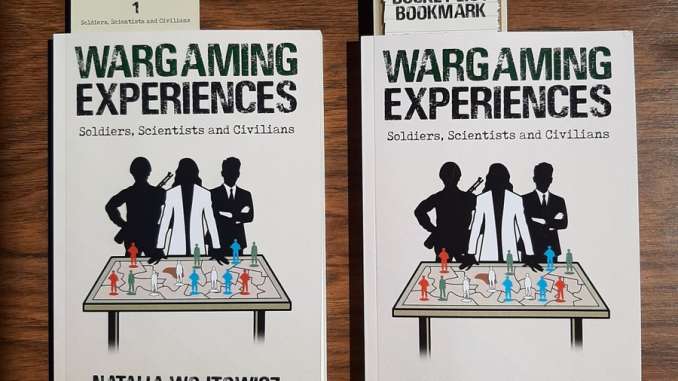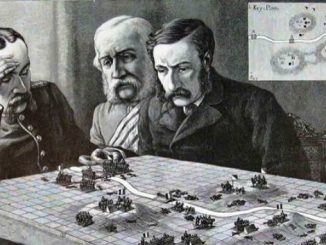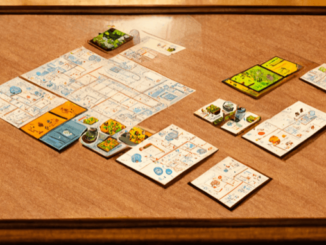
Wargaming Experiences is available on Amazon
Ever wondered what the recent use of gaming-based methodologies in typical NATO scenarios could look like? Natalia Wojtowicz presents her personal insights from her practice in “Wargaming Experiences – Soldiers, Scientists and Civilians”.
Lately, there had been a push for new wargames and related publications, so why there is a need for this new 188-page paperback? To put it briefly, the book contributes to create multiple perspectives on this complex and intensely debated methodology. The author writes down her view from a scientific perspective, as a practitioner, as well as a gaming enthusiast.
“Wargaming Experience” is structured conventionally, with five introductory chapters on the basics, pros and cons, as well as possible applications of wargaming in various disciplines and areas. The following ten chapters take the reader through the author’s journey of designing and executing game-based methodologies during her years working for NATO. This covers nine practical cases (reaching from civil-military cooperation via operations in urban terrain up to CBRN defence and pandemics), which are described comprehensively and comparatively according to her so-called “Wojtowicz Protocol”. In the final chapter, she summarises her essential findings and gives her recommendations. An up-to-date and elaborate bibliography is attached.
It is a quick read because Natalia Wojtowicz writes in a very structured way with lots of clear-cut examples. She aggregates classic wargaming with other game-based methodologies. Even if the described cases focus on applications in a military surrounding, they broaden the view by integrating relevant aspects from various disciplines such as politics, medicine, economy, or even law.
The author emphasizes a comprehensive and holistic perspective on security, therefore searching for positive and cooperative solutions, not only escalation or even destruction. She reflects clearly the thinking and organisational patterns, admitting that some games cannot be won and that being evil is sometimes the easiest way to act.
Her approach that games have to serve a defined purpose and to address certain problems seems to be convenient, likewise her advice to foster transparency in design, cross-checking designs with reality, as well as having a clear plan for analysis of the gaming iterations. Her recommendation for real-world scenarios is to be highlighted, allowing for historical comparison and seeming to evoke deeper involvement of the participants. Written in a very self-critical style, the book does not withhold the criticism and setbacks personally experienced, even when they are the source of some frustration.
Natalia Wojtowicz has added a substantial building block to the diversity of the wargaming community illustrating a broad range of games, and casting an eye over civil aspects and practical recommendations. She provides practical hints for coping with sceptical environments and motivation to get from discovery mode to design mode. Thus she encourages you to adapt the described examples for client work, as well as using them to inform your own game designs.
If I had some criticism to make, it would be that some parts of the basic chapters have been treated superficially. The fact that NATO and its member states have access to a vast ecosystem of analysts and wargaming specialists, including regular panels and conferences, is only mentioned in passing. This might not be caused by the author’s negligence but by the often-criticised “closed shop” mentality of this specialists’ community. Furthermore, a list of other played games, mentioned in notes, would come in handy as a recommendation and as an option to get a closer picture of the author’s gaming life.
As a conclusion, “Wargaming Experience” is definitely recommended to read, especially for those in the defence and security environment who start applying game-based methodologies, e.g. as a teacher or tutor, or those who initiate a professional career as designer or analyst in this field. For those die-hard wargamers, it is at least worth getting some inspirations for their next campaigns and upcoming projects.
Natalia later wrote this “missing introduction” article for Ludogogy.
Wargaming Experiences is available on Amazon
- Review – Wargaming Experiences – Soldiers, Scientists and Civilians - 17th July 2020




I also think that more recent games are adding to that body of work. NATO is revamping a lot of wargaming depth and methods ..
Here are details of a game I took part in about 2 weeks before the invasion of Ukraine. The actual invasion, as mentioned in the post, followed rather closely some of the game play…
https://warontherocks.com/2022/03/the-wargame-before-the-war-russia-attacks-ukraine/